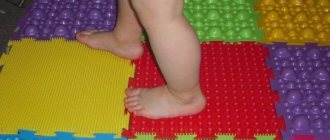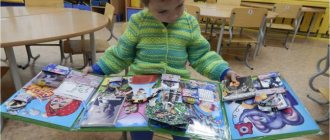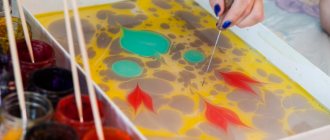Definition
Mnemonics (mnemonics) is a list of methods and techniques that help remember various types of information.
Mnemonics is based on the principle of visualizing abstract objects, which are replaced by specific concepts or figurative definitions. To easily and quickly memorize the necessary information, you need to associatively associate it with some visual idea, sound image or sensation. Associations - establishing connections with known images and phenomena.
Mnemonics for learning vocabulary words: techniques, word associations
To study vocabulary words, the following types of mnemonics are used:
- Visual associations.
- Sound associations.
- Mnemonics of “connections” and many others.
Children like visual associations the most. While memorizing a certain word, invite your child to look at a picture that will represent the word, plus he will be able to play with a letter that is difficult to remember. For example, draw the word “Magnet” and the letter “A” in the picture. When choosing other words, focus on those letters that your baby cannot say or write.
Also, in other words, depict the letters that cause difficulties for the child while writing with pictures, taking into account the meaning of the word itself. In the word “Kopeyka” the second letter is very similar to a penny. Therefore, draw her instead.
The next technique is sound associations. For example, the word “Breakfast” is similar to the word “Cancer”. By combining these words into one single phrase, you can get the sentence: “ There will be boiled crayfish breakfast .” Your child will learn this word using sound association. And the phrase itself sounds more melodic, therefore, it is remembered without problems.
Mnemonics for children
Over the past few decades, this innovative direction in pedagogy and speech therapy has become popular. Kindergarten teachers began to pay more attention and time to speech development.
Classes are held in groups where children get acquainted with works of art, poetry, and fairy tales. It is especially useful to memorize poems and read them with expression. This trains memory, shapes speech, and enriches vocabulary.
Expressiveness of performance develops speech technique - diction, breathing. To do this, special exercises are carried out to help develop speech hearing and clear pronunciation of sounds and words. Also, the educational program of the preschool educational institution includes classes on mnemonics.
From what age is it used?
Teaching children using mnemonics can begin from a very early age. Getting to know exercises for children starts with simple techniques.
First, they use mnemonic squares, which can be introduced to children at the age of three. In the first lessons, children study simple images that represent one word, phrase or simple phrase. You can place pictures in a square and learn poems with movements.
Later, at 4-5 years old, children become familiar with mnemonic tracks - systematized pictures of four drawings. With the help of such images, the concept of sequences is formed. Thanks to group illustrations, you can easily tell a short story, remember the steps of washing your hands, the process of dressing or washing your face.
Children aged 6-7 years begin to study mnemonic tables that allow them to perform more complex actions:
- retell various works;
- memorize poems and complex words;
- guess and make riddles;
- find rhymes for words;
- invent fairy tales or stories;
- distribute objects into groups according to certain characteristics;
- study numbers;
- become familiar with the basic rules of life safety and behavior in various places, and methods of self-service.
Children learn to express their thoughts correctly and beautifully and use new words in speech. Attention and intelligence develop, the ability to highlight the main thing and compare improves.
Mnemonic techniques
- Eidotehnika (eido - image) - representation of an object outside the zone of perception, i.e. application of imaginative thinking. The exercise is aimed at creating images, objects, and natural phenomena.
- Associative chain technique . Words are connected in order, one after another, without skipping. The result is a story or fairy tale. In this game, children quickly remember a chain of words.
- The Cicero method is the placement of information in space. The essence of the method is the imaginary placement of images in a specific place.
- Method of transformation (transformation). Exercise promotes the development of memory and logical thinking. The words seem to flow from one another, something unites them.
- Support method (numeric-letter method). Children remember information by associating the meaning of certain words, sounds and numbers.
- “Croqueting” technique (from the French word croquis - drawing, sketch). Method of graphic associations. The essence is to recode the information received when drawing objects and natural phenomena.
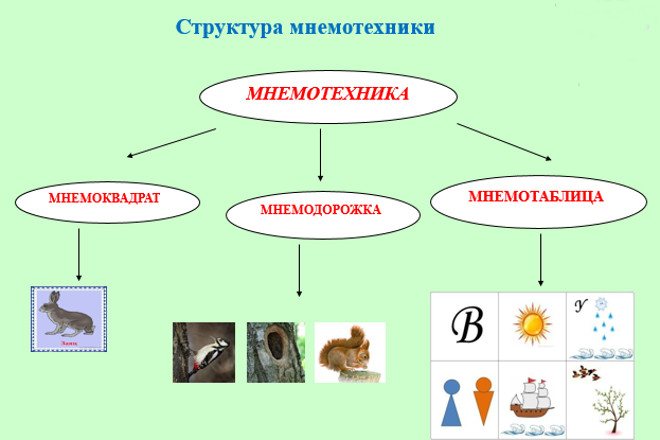
Mnemonic table, mnemonic square, mnemonic track, collage - these are the teaching tools of the crocheting method.
Mnemonic tables are images containing information. They reduce learning time and at the same time develop memory, attention, and creative thinking. Help transform abstract images into concrete objects.
A mnemonic square is a card with an image of encoded information.
Mnemonic track is a sequential distribution of mnemonic squares according to which the child composes a story.
Collages are aids that perform the following tasks:
- teach (thematic collages);
- remember;
- form the skill of attention distribution.
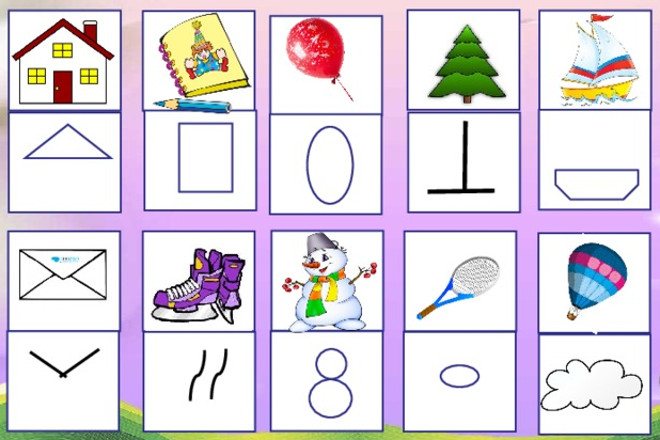
Exercises for preschoolers
Preschool age is considered a favorable period for laying the foundations of competent, clear, beautiful speech. Mnemonics for beginners (simple, fun tasks, games) will help your child’s speech develop faster. It is useful for the development of the articulatory apparatus to perform tasks using onomatopoeic words. They correct diction well - pure jokes (“If only there was smoke coming out of the chimney”), nursery rhymes, phrases containing a certain group of sounds (“Sanya’s sleigh rides on its own”).
Exercises on the pronunciation of hissing sounds can be combined thematically.
After looking at the picture “Hedgehog and Hedgehogs,” the adult offers to complete a number of tasks. The child must clearly pronounce phrases with the sounds “sh” and “zh”. “Sha-sha-sha - we walk slowly; shu-shu-shu - I’ll give the baby a raspberry; shi-shi-shi - where the kids walk.” Such exercises help you master question intonation and develop a sense of rhythm.
By isolating the sound while clearly pronouncing a word, the skill of understanding the terminology “sound” and “word” is developed. When working with children, it is necessary to emphasize the development of intonation sense, rate of speech, diction, and strength of voice. Games can help with this.
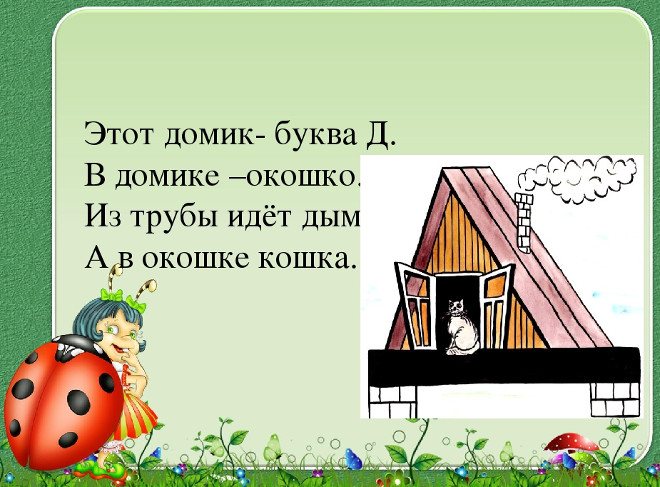
Exercises for beginners:
- "Whose voice is this ? The goal of the game is for the child to learn to recognize adult animals from young animals by the reproduced sound. For such a game, you can take figurines of a dog and a puppy, a duck and a duckling, a cat and a kitten. Alternatively, you can sculpt animals from plasticine or use cards. The plot of the game: animals come to visit the baby, they want to play with him. Children should understand the difference between how a mother cat meows and how her baby meows.
- Game "Compare the cubes" . The task is to teach the child to correlate objects with different characteristics. An adult offers to look at two cubes and tell how they differ. The kid takes one cube and says that it is big, and the second cube is small. The first cube is red and the second is white. The red cube is plastic, the white cube is made of fabric and is soft inside.
- Game “Compare two kittens” . The child is asked to look at the kittens. One of them is white and large, and the second is black and smaller. You need to say who they are. Come up with names for them so that it is clear that one kitten is black and the other is white. What is the difference.
- Game “What little animals can do . The goal of the game is to choose verbs that denote the characteristic actions of animals. An adult shows pictures of animals, and the child must say what they can do or what they say. For example, a cat loves mice. She loves to meow. The dog loves to bark and eat bones, run and jump. The cockerel crows and loves to peck grains.
- Game "Profession" . Here you will need cards that depict people of different professions (pilot, hairdresser, doctor, cook). An adult asks who heals people. The kid must answer correctly. This is how the remaining cards are played.
- The game “Wizards” helps expand vocabulary, develops long-term memory and logical thinking. You will need cards with images of individual objects - a table, an apple, a door. The adult names several words, and the child must choose those cards that will help him remember the named words. He kind of “bewitches” them into these cards. Then the baby takes the cards and with their help remembers the named words. The game is aimed at understanding the logical connections between objects.
Regular playful activities help to awaken interest in words. The exercises prepare children for further independent compilation of narratives, stories, texts, and form connected speech.
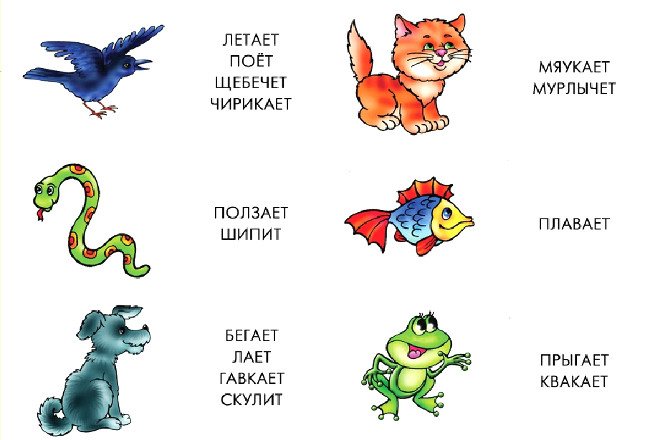
Methodological development “Development of speech of preschool children using mnemonics”
Content:
1. Relevance of methodological development. Page 3-4
2. Features of speech development in children 3-4 years old. Page 5-6
3. The use of mnemonics for the development of children's speech. Page 7-13
3.1 Mnemonic tables for compiling descriptive stories
3.2 Mnemonic tables for memorizing poems
3.3 Mnemonics tables for retelling
3.4 Mnemonics tables for words
3.5 Mnemonics for composing sentences
4. Calendar-thematic plan for working with children of the second junior group. Page 14-19
5. List of references. Page 20
6. Appendix Page 21-35
Relevance
The role of speech in a child’s development cannot be overestimated. Speech contributes to the formation of intelligence, increases cognitive activity, and significantly expands the horizons of a small person. Today, figurative speech, rich in synonyms, additions and descriptions, in preschool children is a very rare phenomenon.
The problem of developing children's coherent speech is well known to a wide range of teaching staff. Knowledge of your native language is not only the ability to construct sentences correctly. Children master their native language through speech activity, through speech perception and speaking. That is why it is so important to create conditions for children’s well-connected speech activity, for communication, for expressing their thoughts. It is necessary to teach children to express their thoughts coherently, consistently, and grammatically correctly, to be able to describe an object coherently and consistently, and to be able to talk about various events from the life around them.
Currently, for the development of coherent speech in preschool children, mnemonic techniques have found widespread use in pedagogical practice. Mnemonics is a system of methods and techniques that ensure effective memorization, storage and reproduction of information. The relevance of mnemonics for preschoolers is due to the fact that it is at this age that visual-figurative memory predominates in children. Most often, memorization occurs involuntarily, simply because some object or phenomenon came into the child’s field of vision. If he tries to learn and remember something that is not supported by a visual picture, something abstract, then he should not count on success. Mnemonics for preschoolers help simplify the memorization process, develop associative thinking and imagination, and increase attentiveness. Moreover, mnemonics techniques, as a result of the competent work of the teacher, lead to the enrichment of vocabulary and the formation of coherent speech. Mnemonics techniques facilitate memorization in children and increase memory capacity through the formation of additional associations.
All this determined the relevance of the problem of the insufficient level of development of coherent speech in children and made it possible to formulate the topic of methodological development: the development of coherent speech in children using mnemonics.
Problem:
insufficient level of mastery of coherent speech by children of the second youngest group.
Target:
the use of mnemonics technology in educational activities with children of the second junior group
Tasks:
· Promote the development of coherent speech;
· Expand and enrich children's vocabulary;
· Develop basic mental processes – memory, attention, imagination
thinking;
· Learn to recode abstract symbols into images (recoding information)
· Teach how to work with mnemonic tables.
2.Features of speech development in children 3-4 years old.
Junior preschool age (3 - 4 years), is characterized by high intensity of physical and mental development. The child’s activity increases and its focus increases; movements become more diverse and coordinated. The leading type of activity at this age is objective-effective cooperation. The most important achievement of this age is that the child’s actions become purposeful. Children of this age have a pronounced need to communicate with adults and peers. Throughout early preschool age, interest in communicating with peers develops. The first “creative” associations of children arise in games. In play, the child takes on certain roles and subordinates his behavior to them. At this age, significant changes occur in the development of speech, the formation and development of all aspects of speech: phonetic, lexical, grammatical.
By the end of the fourth year, the child's vocabulary reaches approximately 1500 - 2000 words. The vocabulary is also becoming more diverse in terms of quality. In the speech of children of this age, in addition to nouns and verbs, other parts of speech are increasingly found: pronouns, adverbs, numerals appear (one, two), adjectives indicating abstract signs and qualities of objects (cold, hot, hard, good, bad) . The child begins to use function words (prepositions, conjunctions) more widely. By the end of the year, he often uses possessive pronouns (my, yours) and possessive adjectives (daddy's chair, mommy's cup) in his speech.
Simultaneously with the enrichment of the vocabulary, the child more intensively masters the grammatical structure of the language. Three-year-old children speak in short phrases consisting of several words (usually 3-4). Gradually the phrase lengthens and becomes more complex. In a child of this age, a number of imperfections in phrasal speech can be noted: incorrect word order in a sentence, errors in word agreement.
The sound pronunciation of children of the second youngest group is also characterized by a number of features. For example, consonants are pronounced softly, a number of sounds are pronounced unclearly, are skipped or replaced. Many children have slurred, unclear speech. This is a consequence of sluggish, lackluster movements of the lips and tongue, and low mobility of the lower jaw. Special exercises (articulation gymnastics) are required for the muscles of the speech apparatus.
The development of coherent speech plays a leading role in the process of speech development of the child and occupies a central place in the overall system of work on speech development. Coherent speech absorbs all the child’s achievements in mastering his native language, its sound structure, vocabulary, and literate structure.
The development of coherent speech occurs gradually along with the development of thinking and is associated with the complication of children's activities and forms of communication with people around them. Purposeful teaching of coherent monologue speech begins in the second junior group. Children are taught to retell fairy tales and stories that are well known to them, as well as to tell stories based on visual material (descriptions of toys, stories based on a picture with a plot close to their childhood experience - from the series “We Play”, “Our Tanya”). The teacher, through dramatization of familiar fairy tales, teaches children to compose statements of narrative type. He tells the child the ways of connections in a sentence, sets the pattern of statements (“The bunny went... There he met... They became...”), gradually complicating their content, increasing their volume.
If monologue speech develops in teaching children, then one of the conditions for the development of dialogic speech is the organization of the speech environment, the interaction of adults with each other, adults and children, and children with each other.
3.
The use of mnemonics for the development of children's speech.
Mnemonics is the art of memorization, a set of techniques and methods that facilitate memorization and increase memory capacity through the formation of artificial associations.
This technology is organically integrated into the educational process and is used to implement the tasks of all educational areas: “Speech development”, “Cognitive development”, “Social and communicative development”, “Artistic and aesthetic development”, “Physical development”.
Mastering the techniques of working with mnemonic tables significantly reduces training time and at the same time solves problems aimed at:
· development of basic mental processes - memory, attention, imaginative thinking and speech;
· recoding of information, i.e. transformations from abstract symbols to images;
· development of fine motor skills of the hands with partial or complete graphic reproduction.
How to use mnemonics in kindergarten? Mnemonics in kindergarten, as an effective method of memorization, are usually mastered using simple examples. To begin with, children are introduced to mnemonic squares - clear images that represent one word, phrase, its characteristics or a simple sentence. Then the teacher complicates the lessons by demonstrating mnemonic tracks - this is a square of four pictures, from which you can compose a short story in 2-3 sentences.
And finally, the most complex structure is mnemonic tables. The content of a mnemonic table is a graphic or partially graphic representation of fairy tale characters, natural phenomena, some actions, etc. by highlighting the main semantic links of the story’s plot. The main thing is to convey a conditionally visual diagram, depict it in such a way that what is drawn is understandable to children. Initially, the tables are compiled by educators and parents, then the child can be involved in this process, thus, mnemonics will affect not only the development of memory, but also imagination , visualization of images by a child.
When working with children, it is advisable to use mnemonic tables for:
· enrichment of vocabulary;
· when learning to write stories;
· when retelling fiction;
· when guessing and making riddles;
· when memorizing poetry.
Subject-schematic models of mnemonics used for the development of speech in preschoolers must meet certain requirements:
a) clearly reflect the basic properties and relationships that are the object of cognition, be similar in structure to the object being studied;
b) clearly and clearly convey those properties and relationships that must be mastered with its help;
c) be easy to understand and accessible to create and act with;
d) an atmosphere must be created, freedom of creativity, each child can have his own model - the one he thinks and imagines;
It is difficult for children of primary preschool age to grasp educational information immediately through a mnemonic table, so it is more convenient to work with them using mnemonic tracks. The mnemonic track also carries educational information, but in small quantities, which is very important in the early stages of a child’s education.
You can work with a mnemonic track using overlay techniques and applications (often used in working with children of primary preschool age), excluding at first the method of partial or complete graphic sketching.
Thus, with the help of mnemonic tables and model diagrams, it is possible to achieve the following results:
· children's knowledge about the world around them increases;
· there is a desire to retell texts and come up with interesting stories;
· there is an interest in learning poems and nursery rhymes;
· vocabulary reaches a higher level;
· children overcome timidity, shyness, learn to behave freely in front of an audience.
Mastering the techniques of working with mnemonic tables significantly reduces training time. Using supporting drawings to teach memorizing poems captivates children and turns the activity into a game.
Stages of working on a poem:
1. The teacher reads the poem expressively.
2. The teacher informs that the child will learn this poem by heart. Then he reads the poem again using the mnemonic table.
3. The teacher asks questions about the content of the poem, helping the child understand the main idea.
4. The teacher finds out which words are incomprehensible to the child and explains their meaning in a form accessible to the child.
5. The teacher reads each line of the poem separately. The child repeats it using a mnemonic table.
6. The child recites a poem based on a mnemonic table.
Mnemonic tables can be used when teaching children how to compose stories, retell fairy tales, learn riddles, and nursery rhymes in all age groups of preschool educational institutions.
For children of primary preschool age, colored mnemonic tables are best suited, since children retain individual images in their memory: a green Christmas tree, a yellow bun, etc. Later, the images become more complex or are replaced by a graphic image: a fox - orange geometric shapes (circle, square ) etc. For older children, the diagrams are given in one color.
The visual image that the child retains after listening, accompanied by viewing the drawings, allows him to remember the text much faster. To learn each poem, a mnemonic table is developed and compiled, and pictures are selected for the selected poem (preferably for each line). And so, step by step, a mnemonic table is created.
At a younger preschool age, mnemonic tables are given in a ready-made version, since children have insufficiently developed technical drawing skills, but at an older preschool age, an adult gives a plan diagram only at the initial stage; as they learn, children are actively involved in the process of creating their own diagram.
Thus, using mnemonic techniques, children learn:
1. Obtain information, conduct research, make comparisons, compile
a clear internal plan of mental actions, speech statements;
2. Formulate and express judgments, draw conclusions;
3. The use of mnemonic techniques has a positive effect
on the development of non-speech processes: attention, memory, thinking.
It follows that the child (under the guidance of adults) after analyzing the new
material and graphic designation, learns independence, perseverance,
visually perceive your action plan. His feeling increases
interest and responsibility, satisfaction with the results of one’s work appears, mental processes such as memory, attention, thinking are improved, which has a positive effect on the effectiveness of all work.
3.1
Mnemotables for compiling descriptive stories
A visual diagram acts as a plan for a speech utterance. The child knows where to start, how to continue and refine his story, and how to complete it. This is achieved by using certain symbols indicating various characteristics of objects. For example:
– color
– children draw color spots;
– form
- name what shape the object itself or its parts have;
– magnitude
– draw two objects of contrasting size;
– Human
– why a person needs an object, how a person takes care of it (if it is a living creature or plant), or how a person uses it (if it is an inanimate object);
– contour from the details of an object
– the details of the object are indicated, the child must name what parts the object consists of;
– hand
- what actions are performed with this item, what can be prepared, for example: from apples you can make apple compote, jam, bake an apple pie;
– question mark
– name of the item or object;
– Exclamation point
– emotions and feelings that this object evokes.
Stages of working with a mnemonic table to compile a descriptive story:
1. Consideration of the mnemonic table.
2. Conversation on the content of the symbols, each point of the plan.
3. Drawing up a descriptive story using a mnemonic table for adults.
4. Compiling a descriptive story using a mnemonic table by a child.
3.2.Mnemonic tables for memorizing poems
Using supporting drawings to teach memorizing poems captivates children and turns the activity into a game. This method is especially effective for children of preschool age, since in preschoolers visual-figurative memory predominates, memorization is mainly involuntary. The visual image that the child retains after listening, accompanied by viewing the drawings, allows him to remember the text much faster. First, the adult selects a poem and supporting pictures for it (preferably for each line). Pictures should be bright and recognizable. When reading a poem, pictures are placed on the board. Then, after reading the poem to adults, children reproduce this poem using reference pictures.
When memorizing poems at later stages, the work is carried out in the following sequence: first, an adult selects a poem, encodes it using symbols, reads it expressively to the children, and while reading, schematically depicts the text using drawings. Then the text is reproduced based on the drawings of an adult together with the children, then the children read the poem in chorus, in groups, one at a time, at will. The picture table hangs in a visible place in the group room during the day so that children can tell the text to each other if they wish.
Stages of working with a mnemonic table for memorizing a poem:
1. An adult explains to the child the meaning of difficult words. The child repeats them.
2. An adult reads the poem expressively.
3. The adult says that the child will learn this poem by heart. Then he reads the poem again using the mnemonic table.
4. An adult asks questions about the content of the poem, helping the child understand the main idea.
5. An adult reads each line of the poem separately. The child repeats it using a mnemonic table.
6. The child recites a poem based on a mnemonic table.
3.3
Mnemonic tables for retelling
At the initial stages of teaching retelling, you can use illustrated panels and supporting pictures, then the illustrations should be replaced with conditional diagrams that help children learn to draw up a retelling plan. At later stages, you can use simple drawings and diagrams that preschoolers themselves draw up.
Stages of working with a mnemonic table for retelling text:
1. An adult explains to the child the meaning of difficult words. The child repeats them.
2. Reading the text to adults with a demonstration of the plot picture.
3. Conversation on the content of the text.
4. Repeated reading of the text by adults with a focus on retelling based on a mnemonic table.
5. Retelling the story by a child based on a mnemonic table.
3.4
Mnemonics for words
Children are offered a mnemonic table for a specific word on a lexical topic. This technique serves not only to expand the associative vocabulary, development of logical thinking and memory of preschoolers, but also promotes the development of coherent speech, since children need to explain why this or that object is drawn in a given cell, the development of fine motor skills, because it is necessary to quickly diagram his. At the initial stages of work, an adult fills out a table together with children (an adult on the board, children in their notebooks); at later stages of learning, children fill out the table independently. When this task has been mastered, you can invite preschoolers to create a mnemonic table for one of the words on a lexical topic on their own.
Stages of working with a mnemonic table for a word:
1. Consideration of the mnemonic table.
2. Recoding of information.
3. Reproducing the table from memory.
3.5
Mnemonics for composing sentences
A special feature of the mnemonic track is that a picture is selected for each word of the sentence. A child, answering an adult’s question with the help of a mnemonic track, learns to use the correct word order in a sentence, form it grammatically correctly, and also answer the question in a complete sentence.
4. Calendar-thematic plan for working with children of the second junior group.
| Month | Theme of educational activities | Objectives of educational activities |
| September | Nursery rhyme “Like our cat” | Introduce children to mnemonic squares and mnemonic track. To develop in children the ability to identify the characteristic features of an animal. To develop in children the ability to expressively tell a nursery rhyme using a mnemonic track |
| Nursery rhyme “Mice dance in circles” | Continue introducing children to mnemonic tracks for nursery rhymes. To develop in children the ability to tell a nursery rhyme expressively using a mnemonic track. Cultivate interest in Russian folklore. | |
| October | "Golden Autumn" | Continue to introduce children to the characteristics of the seasons. Learn to talk about the signs of autumn using a mnemonic track. To cultivate in children aesthetic feelings and interest in nature. |
| Poem by A. Pleshcheev “Autumn has come” (abbreviated) | To develop in children the ability to expressively recite a poem based on a mnemonic track. Expand children's understanding of the characteristic features of the seasons. Learn to identify the mood expressed in a poem. | |
| Russian folk tale "Kolobok" | Teach children to consistently retell familiar fairy tales using a mnemonic track. Develop children's coherent speech. To develop the ability to understand and evaluate the actions of heroes. | |
| Poem by V. Mirovich “Falling Leaves” | Continue to develop in children the ability to expressively recite a poem using a mnemonic track. Enrich children's active vocabulary. Cultivate a love for autumn nature. | |
| November | Russian folk tale "Turnip" | Teach children to retell a fairy tale coherently and consistently using a mnemonic track. Develop attention, memory, coherent speech. Cultivate a desire to help each other. |
| Poem by O. Vysotskaya “In our kindergarten” | Introduce children to the mnemonic table for the poem. Continue to develop in children the ability to expressively recite a poem based on visualization. Develop attention, memory, coherent speech. Cultivate friendly relationships and respect for kindergarten employees. | |
| Russian folk tale "Teremok" | Teach children to retell a fairy tale coherently and consistently using a mnemonic track. Activate words and expressions in speech that allow you to begin and end a fairy tale. Develop attention, memory, coherent speech. Expand children's knowledge about the distinctive features of wild animals. | |
| Poem by G. Lagzdyn “Washing” | Continue to develop in children the ability to expressively recite a poem using a mnemonic track. Develop attention, memory, coherent speech, intonation expressiveness of speech. Cultivate respect for the work of adults and the desire to help them. | |
| December | "Zimushka-winter" | Continue to introduce children to the characteristics of the seasons. Learn to talk about the signs of winter based on a mnemonic table. To develop the ability to correlate iconic symbols with images. Develop children's attention, memory, and coherent speech. To cultivate in children aesthetic feelings and interest in nature. |
| Russian folk tale "Rukavichka" | Teach children to retell a fairy tale coherently and consistently using a mnemonic table. Develop attention, memory, coherent speech. Learn to name the distinctive features of wild animals. Activate words in speech that allow you to begin and end a fairy tale. Encourage emotional responsiveness in children. | |
| Poem “Christmas tree” by K. Chukovsky | Continue to develop in children the ability to expressively recite a poem using a mnemonic track. Develop children's attention, memory, and coherent speech. Teach children to answer questions posed by the teacher. Cultivate an interest in poetry. | |
| Poem by O. Vysotskaya “Sled” | Promote figurative perception of the poem. Activate children's own memories. Develop children's attention, memory, and coherent speech. Continue to develop in children the ability to expressively recite a poem based on a mnemonic table. | |
| January | Poem by S. Marshak “January” | Promote figurative perception of the poem. To develop in children the ability to expressively recite a poem based on a mnemonic table. Expand children's knowledge about winter natural phenomena. Develop children's attention, memory, and coherent speech. To cultivate an aesthetic attitude towards the surrounding nature. |
| Poem by Asen Bosev “Three” | Promote figurative perception of the poem. Continue to develop in children the ability to expressively recite a poem based on a mnemonic table. To consolidate children's knowledge about the characteristic signs of winter. Develop attention, memory, coherent speech. Cultivate emotional responsiveness in children. | |
| February | Poem by O. Chusovitina “My Best Dad” | Promote figurative perception of the poem. Continue to develop in children the ability to expressively recite poetry based on a mnemonic table. Encourage children to want to talk about their dad and grandfather. Develop attention, memory, coherent speech. Cultivate respect and love for your family members. |
| Poem by V. Berestov “The cockerels have fled” | Continue to develop in children the ability to expressively recite a poem based on a mnemonic table. To develop the ability to correlate iconic symbols with images. Develop attention, memory, coherent speech. Cultivate friendly relationships. | |
| Russian folk tale "Masha and the Bear" | Teach children to coherently and consistently retell familiar fairy tales based on a mnemonic table. Develop attention, memory, coherent speech. Expand children's active vocabulary. Develop the ability to empathize with the heroes of a fairy tale. To educate the moral qualities of children. | |
| Russian folk tale "Zayushkina's hut" | Continue to develop in children the ability to tell a fairy tale based on a mnemonic table. Develop attention, memory, coherent speech. To form in children ideas about the concepts of good and evil. Cultivate a desire to help others. | |
| March | "Spring is Red" | Continue to introduce children to the characteristics of the seasons. Learn to talk about the signs of spring based on a mnemonic table. To develop the ability to correlate iconic symbols with images. Develop children's attention, memory, and coherent speech. Improve the grammatical structure of speech. To cultivate in children aesthetic feelings and interest in nature. |
| Poem by O. Chusovitina “A gift for Mommy” | Continue to develop in children the ability to expressively recite a poem based on a mnemonic table. Develop attention, memory, coherent speech. Develop intonation expressiveness of speech. Cultivate a kind, respectful attitude towards mother, the ability to express your love in words and actions. | |
| Russian folk tale “Fear has big eyes” | Continue to develop in children the ability to tell a fairy tale based on a mnemonic table. To form an idea of the feeling of fear by referring to the personal experience of children. Cultivate interest in Russian folk art. | |
| Poem by A. Leontyev “Drip-drip” | To consolidate and expand children's knowledge about the characteristic signs of spring. Continue to develop in children the ability to expressively recite a poem based on a mnemonic table. Develop attention, memory, coherent speech. Develop intonation expressiveness of speech. | |
| April | Russian folk tale "The Cockerel and the Bean Seed" | Continue to develop in children the ability to tell a fairy tale based on a mnemonic table. Develop attention, memory, coherent speech. Expand children's knowledge about the work of adults. Cultivate interest in Russian folk tales. |
| Poem by A. Pleshcheyev “Rural Song” | Expand children's understanding of the characteristic signs of spring. Continue to develop in children the ability to expressively recite a poem based on a mnemonic table. Develop attention, memory, coherent speech. Expand children's active vocabulary. Cultivate a love of literary creativity. | |
| Poem by G. Sapgir “Cat” | Continue to develop in children the ability to expressively recite a poem based on a mnemonic table. Develop attention, memory, coherent speech. Develop intonation expressiveness of speech. Cultivate a love for pets. | |
| Russian folk song “Rabushechka Hen” | Develop attention, memory, coherent speech, intonation expressiveness of speech. Continue to develop in children the ability to expressively recite a poem based on a mnemonic table. To develop the ability to correlate iconic symbols with images. Expand children's knowledge about poultry. Cultivate an interest in poultry and a caring attitude towards them. | |
| May | Poem by N. Nishcheva “A striped bee flew to us yesterday” | Continue to develop in children the ability to expressively recite a poem based on a mnemonic table. Teach children to find the distinctive features of insects. Develop attention, memory, coherent speech. Cultivate a careful, caring attitude towards insects. |
| Poem by E. Serov “Dandelion” | Continue to develop in children the ability to expressively recite a poem based on a mnemonic table. To develop the ability to correlate iconic symbols with images. Develop attention, memory, coherent speech. Develop intonation expressiveness of speech. To educate children's aesthetic senses. | |
| Russian folk tale “Cat, fox and rooster” (modeled by M. Bogolyubskaya) | Expand children's knowledge about domestic and wild animals. Continue to develop in children the ability to tell a fairy tale based on a mnemonic table. To develop the ability to correlate iconic symbols with images. Develop attention, memory, coherent speech. To develop the ability to empathize with the characters of a fairy tale. | |
| Poem by V. Berestov “Summer” (abbreviated) | Continue to develop in children the ability to expressively recite a poem based on a mnemonic table. To consolidate children's knowledge about the characteristic features of the seasons. Develop attention, memory, coherent speech, intonation expressiveness of speech. |
Bibliography:
1. Bolsheva T.V. We learn from a fairy tale. Development of thinking in preschoolers using mnemonics. St. Petersburg: “Childhood-Press”, 2001.
2. Omelchenko L.V. Cognitive and speech development of preschool children using mnemonics. M.-Uchitel, 2019
3. Omelchenko L.V. The use of mnemonic techniques in the development of coherent speech // Speech therapist. M., 2008.-No.4.-P.102-115.
4. Polyanskaya T.B. Using the mnemonics method in teaching storytelling to preschool children. St. Petersburg. - Childhood-Press, 2010.
5. Potashko I.A. The use of mnemonic tables in the development of primary natural science concepts in preschoolers.//Preschool pedagogy. M, 2006.- No. 7.- P. 18-22.
6. Shirokikh T.T. Learning poetry - developing memory // Child in kindergarten. - 2004. - No. 2. - P. 59-62.
Rules for conducting classes
The process of working and learning with children should be comfortable and beneficial.
- You need to start with simple tasks. First, you can look at cards with single images.
- You should not immediately overload your preschooler; he will quickly get tired and will not absorb the information. You can show no more than two mnemonic tables per day.
- All images of didactic material must be bright and colorful. Children quickly remember colorful images. The grass is green, the carrot is orange, the pine cone is brown, the sea is blue.
- It is worth changing the topic of the lesson every time, otherwise the child will lose interest. Today we are learning poetry. Tomorrow - a fairy tale, wild animals, etc.
- It is important that classes take place only in a playful way.
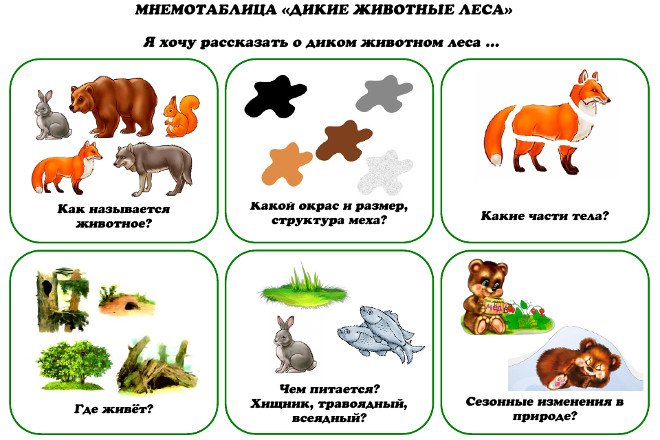
Mnemonics for schoolchildren
The modern student receives a huge amount of information on various disciplines every day. It is very difficult to remember the material received in such a volume. Mnemonics skills will help here, which make it possible to accumulate and retain information.
Mnemonics for memory development is a strong training of attention and thinking. The following techniques will help you remember the information received as much as possible:
- "Make up your own story" . How to remember a list of unrelated words? The simplest thing is to come up with a story. For example, vocabulary words starting with the letter “l”: – labyrinth – on the rides we got confused in the labyrinth; – laboratory - he secretly entered a secret laboratory; – lagoon – the blue lagoon sparkles with sunlight. Next, the student reads the resulting text and retells it. This way he remembers the right words.
- Association cards . This method of taking notes helps you remember what you read. The main topic is written in the center of the sheet, and then secondary topics branch off from it in different directions, like branches of a tree.
- Block diagram . This method helps to structure numbers, tables, symbols, and keywords. The arrows in the diagram indicate the relationship between various data.
- Another proven way to remember information is to try to rhyme it. It is necessary to compose several lines of the necessary information and rhyme them. This should create a short verse. Then repeat several times.
- BCC - alphanumeric code . The technique is used to encrypt numbers and digits into words.
Using mnemonics to help children memorize multiplication tables
The techniques for learning the multiplication tables are very similar to those used for learning a foreign language. Here you can also use cards by writing numbers on them anywhere.
Currently, the following mnemonics methods are considered quite common:
- Technique with 2, 3, 5. This type of mnemonic technique is used, as a rule, at the initial stage of learning the multiplication table. This counting is considered a basic technique that allows you to become familiar with the multiplication table. This method technologically corresponds to the method during which single-digit numbers and their composition are memorized. If your child can master the material, in the future he will be able to cope with the remaining numbers from the table, as well as more complex options, without any problems.
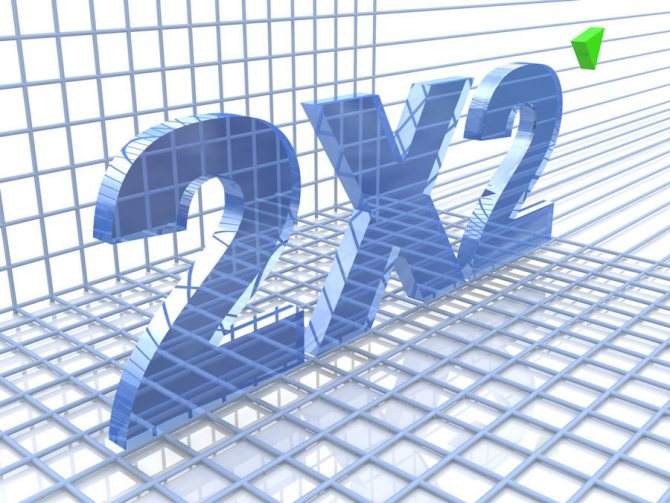
Learning the multiplication table
- Sequential addition. This method directly deals with the addition of identical terms. It is considered convenient even when multiplying 7 or 8, if, of course, the second factor is small. For example, 5x3=5+5+5.
- Adding a summand number to the previous result. This technique is used if the child has already learned something from the multiplication table. For example, 4. Let's continue the example given above. It's easy to remember. But, if you need 5x6, then you can add the missing 5 to the received answer of 15. 15+5+5+5. In addition, the child must also be able to correctly add and subtract up to 100 in his head.
